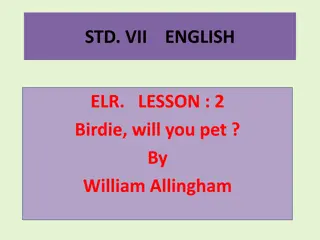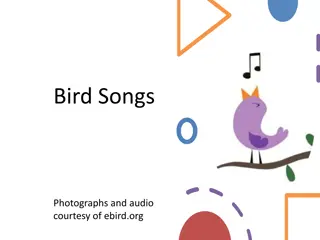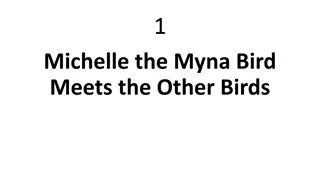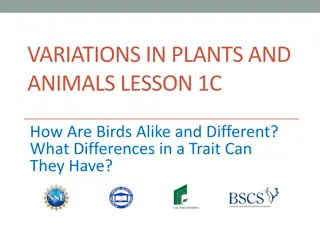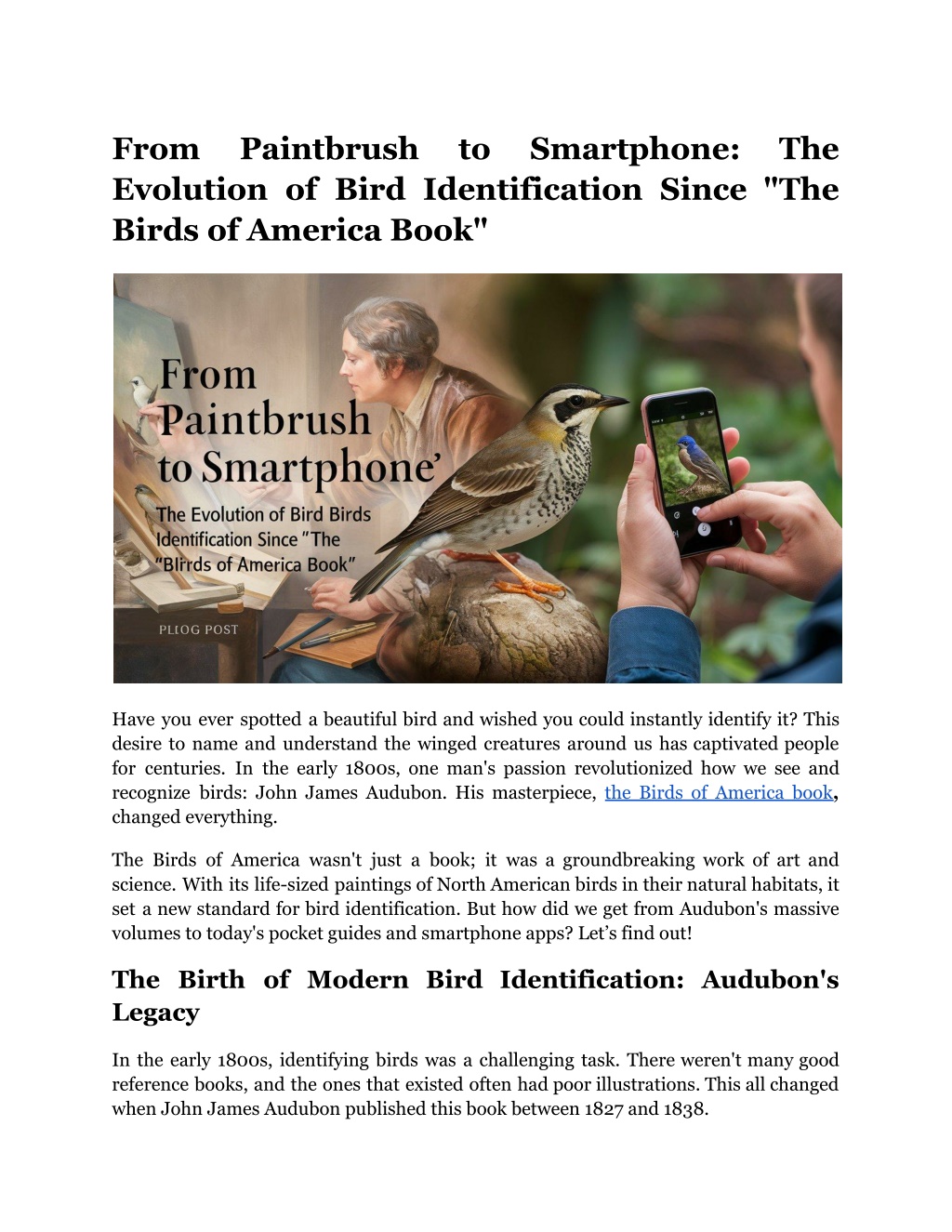
From Paintbrush to Smartphone: The Evolution of Bird Identification Since "The B
Explore the evolution of bird identification from 'The Birds of America' book to modern smartphone apps. Discover how technology has transformed birdwatching.
Download Presentation

Please find below an Image/Link to download the presentation.
The content on the website is provided AS IS for your information and personal use only. It may not be sold, licensed, or shared on other websites without obtaining consent from the author. Download presentation by click this link. If you encounter any issues during the download, it is possible that the publisher has removed the file from their server.
E N D
Presentation Transcript
From Evolution of Bird Identification Since "The Birds of America Book" Paintbrush to Smartphone: The Have you ever spotted a beautiful bird and wished you could instantly identify it? This desire to name and understand the winged creatures around us has captivated people for centuries. In the early 1800s, one man's passion revolutionized how we see and recognize birds: John James Audubon. His masterpiece, the Birds of America book, changed everything. The Birds of America wasn't just a book; it was a groundbreaking work of art and science. With its life-sized paintings of North American birds in their natural habitats, it set a new standard for bird identification. But how did we get from Audubon's massive volumes to today's pocket guides and smartphone apps? Let s find out! The Birth of Modern Bird Identification: Audubon's Legacy In the early 1800s, identifying birds was a challenging task. There weren't many good reference books, and the ones that existed often had poor illustrations. This all changed when John James Audubon published this book between 1827 and 1838.
Audubon's Birds of America was revolutionary for several reasons: Life-size illustrations: Audubon painted birds in their actual size, even for large birds like Wild Turkey. Natural poses: He showed birds in lifelike positions, often interacting with their environment. Detailed observations: Audubon included notes on behavior, habitat, and calls. It contained 435 hand-colored plates, depicting 497 bird species. It was a massive undertaking, both in terms of art and science. The Impact of Audubon's Work Audubon Birds of America book set a new standard for bird identification. It helped people understand: The importance of accurate visual representation The value of observing birds in their natural habitats The need for detailed written descriptions to accompany illustrations After Audubon, more bird guides began to appear, each building on his foundation. Read More Articles: Top 10 Works of Adrien de Montigny: A Journey Through Renaissance Miniatures The Evolution of Bird Guides As time passed, bird guides continued to improve. Here's a quick timeline of major developments: Year Developments 1870s-1900s Field-friendly books appear, smaller and more portable than Audubon's large volumes. 1934 Roger Tory Peterson publishes his first field guide, introducing the Peterson Identification System
1966 The Golden Guide to Birds is released, featuring more illustrations and range maps. 1980s-1990s Photographic field guides become popular, offering real-life images of birds. 2000s-prese nt Digital apps and online resources revolutionize bird identification. The Peterson Identification System Roger Tory Peterson's system was a game-changer for bird identification. It introduced: Arrows pointing to key identifying features Side-by-side comparisons of similar species Simplified illustrations focusing on essential details This system made bird identification more accessible to beginners and is still used in many guides today. Modern Bird Identification Tools Today, bird watchers have many tools at their disposal: Field Guides: Updated versions of traditional books, often with improved illustrations and more species. Apps: Like Merlin Bird ID or eBird, which use AI and user data to help identify birds. Websites: Offering extensive information, photos, and even bird call recordings. DNA Analysis: For extremely similar-looking species. precise identification, especially for Let's compare these tools: Tool Pros Cons
Traditional Field Guides Reliable, needed no batteries Can be heavy, limited to printed info Apps Portable, regularly updated often free, Require need internet smartphone, may Websites Vast community input information, Need internet access, can be overwhelming DNA Analysis Extremely accurate Expensive, not practical for field use The Role of Citizen Science Modern bird identification isn't just about tools it's also about community. Citizen science projects like the Great Backyard Bird Count and eBird allow bird watchers to contribute their observations. This data helps scientists track bird populations and migration patterns. Key Skills for Modern Bird Identification While tools have improved, some skills remain crucial for bird identification: Observation: Noticing details like size, shape, color patterns, and behavior. Listening: Learning to identify birds by their calls and songs. Understanding habitat: Knowing which birds are likely to be found where. Patience: Birds don't always cooperate! Sometimes you need to wait and watch. Tips for Beginner Bird Watchers If you're new to bird watching, here are some tips to get started: Start with common birds in your area Use a combination of field guides and apps Join a local bird-watching group or take a guided tour Practice regularly the more you observe, the better you'll become Keep a record of the birds you see Read More Articles: The Art and Science Behind Audubon's Bird Illustrations
The Future of Bird Identification As technology advances, bird identification continues to evolve. Some exciting developments include: AI-powered binoculars that can identify birds in real-time Improved sound recognition technology for identifying bird calls Virtual reality experiences to practice bird identification Satellite tracking for more accurate migration data The Art of Avian Appreciation: From Audubon to AI As we've journeyed from Audubon's masterpiece to today's AI-powered apps, one thing remains constant: our fascination with birds. While technology has made identification easier and more accessible, the core skills of observation, patience, and appreciation are timeless. Whether you're leafing through a classic field guide or swiping through a smartphone app, remember that each bird identification is a connection to Audubon's legacy. Find the wonders of bird watching with Aradar Books! From beautifully illustrated field guides to in-depth ornithological studies, we offer a wide range of books for bird enthusiasts of all levels. Our collection includes modern reprints of classics like The Birds of America book, so visit our website and take flight into the fascinating world of birds! Site Article: From Paintbrush to Smartphone: The Evolution of Bird Identification Since "The Birds of America Book"










